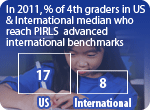

The Progress in International Reading Literacy Study (PIRLS) is an international comparative study of the reading literacy of young students. PIRLS studies the reading achievement and reading behaviors and attitudes of 4th-grade students in the United States and students in the equivalent of 4th grade in other participating countries.
The first administration of PIRLS was in 2001, and included 36 education systems (including countries and subnational entities, such as Canadian provinces and Hong Kong, a Special Administrative Region of the People’s Republic of China). It was followed five years later by the second administration in 2006 to students in 45 education systems. The third and latest administration of PIRLS was in 2011, with 53 education systems participating at grade 4. PIRLS is coordinated by the International Association for the Evaluation of Educational Achievement (IEA).
 You can explore the PIRLS data directly through NCES's online data tool — the International Data Explorer (IDE)
You can explore the PIRLS data directly through NCES's online data tool — the International Data Explorer (IDE)
![]() News and Highlights
News and Highlights
Data Snapshots
